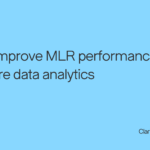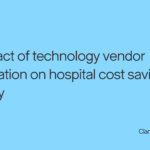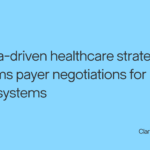Since the Affordable Care Act outlined minimum amounts that health plans must spend on medical care and quality improvement, known as the medical loss ratio (MLR), insurers have focused on improving administrative and clinical efficiency. However, plans continue to face challenges with compliance: insurers estimate they will issue about $1.1 billion in MLR rebates across all commercial markets due to failing to meet this requirement. Health plans need a detailed and comprehensive view of costs across operations to meet these mandates. Healthcare analytics can provide more transparency into these areas, allowing organizations to benchmark provider performance, predict member behavior and risk, and identify areas for efficiency improvement and potential savings. Without comprehensive and detailed visibility into how members use healthcare services and exhibit their care preferences, health plans may offer benefits that don’t align with member’s needs. This can lead members to seek the care they need out of the network or delay primary and preventive care, resulting in missing signs of serious illness or worsening existing conditions. As a result, increased administrative processes like approvals, claims, and appeals related to out-of-network providers and for preventable complications or intensive treatments can drive up those costs, leading to an unfavorable MLR. In addition, plans with benefits that don’t match member needs can lead to member dissatisfaction and a poor reputation. This forces insurers to spend more on marketing efforts to retain and acquire members instead of focusing on care and quality improvement, putting them in danger of noncompliance with MLR requirements. Health plans can use predictive analytics to gain insights into how their members use healthcare services. Platforms can identify what services members use, which are underutilized, and what types of care they seek out-of-network, pointing to where plans can adjust their networks to meet member needs better. Predictive analytics also enable Insurers to see opportunities for proactive interventions among members at high risk for certain conditions by analyzing factors like age, gender, and medical history. This allows plans to head off ER visits and other costly services or treatments by offering screenings, appointment reminders, and other actions that can reduce clinical and administrative expenses. Offering more care that aligns with member needs improves patient outcomes, and keeps costs reasonable also promotes member satisfaction, increasing the likelihood of staying with the plan. This reduces the need for more spending on new member acquisition and onboarding, enabling plans to shift more resources to medical care and quality improvement initiatives. Variations in providers’ quality, efficiency, and commitment to value-based care significantly impact MLR. Providers who consistently provide high-quality care have patients with better outcomes, reducing the incidence of complications and the need for more intensive treatments and hospital readmissions. In contrast, lower-performing providers can drive up costs when inefficient care results in more claims. They may also cause members to be unsatisfied with their care, causing them to leave the plan or seek better-quality care outside the network. However, it can be difficult for health plans to evaluate individual provider performance when data is siloed across different systems or is unavailable. Healthcare data analytics platforms help insurers evaluate provider performance by collecting and analyzing large datasets related to patient outcomes, costs, best practices, and other relevant information. The ability to drill down into and organize data according to different variables enables analytics platforms to create highly accurate models for high quality, cost-effective care. Health plans can use those models to develop performance benchmarks and incentivize providers to meet them. Benchmarking is key to making care delivery more consistent and efficient across all providers, which can reduce costs and support MLR compliance. For example, developing processes for efficient provider collaboration can prevent duplicative or unnecessary services and minimize out-of-network referrals. Traditional cost management methods are insufficient for the complexities of today’s healthcare system. Surface-level approaches like limiting coverage or reducing provider payments are inefficient. They can backfire, leading to worse patient outcomes and potentially causing providers and members to leave the plan—contributing to a downward financial spiral. Instead, health plans need to investigate and address issues such as unnecessary testing and treatments and inefficiencies that can impact care and increase administrative costs. By identifying patterns and relationships within data, analytics platforms generate insights that can uncover significant opportunities for cost management. For example, a data analysis might show that some members incur high costs due to frequent ER visits for asthma. Steps like more attentive management of the condition, ensuring access to inhalers and other medications that prevent or reduce the severity of attacks, and sending personalized messaging about less expensive options for immediate care can divert them from the ER, lowering costs. This allows health plans to allocate more resources toward preventive medical care and quality improvement. Healthcare data analytics give health plans visibility into spending and costs required to optimize MLR. By analyzing MLR data at granular and multifaceted levels, insurers can uncover various opportunities for cost-efficiency and savings. Analytics platforms help make operations more efficient and support overall health plan performance with speed, scale, and accuracy. Over the long term, a data-driven approach to cost-efficiency can help insurers increase their ROI in healthcare and meet MLR mandates more consistently. Understanding member needs for better MLR
Optimizing provider performance to improve MLR
Managing costs with data-driven decision making
Data-driven strategies for improved MLR performance
Payer: Employer Insights | January 29, 2025
How to improve MLR performance with healthcare data analytics
Reporting that’s committed to making healthcare insights accessible to all.

The complexity of healthcare data. Clarified.

Made for your most precise decision-making yet. Introducing the Clarify Atlas Platform®, our healthcare analytics platform and the foundation underpinning each of our building blocks. Atlas powers every decision with clarity brought from 20 billion data points and our best-in-class benchmarking technology.

Made for your most precise decision-making yet. Introducing the Clarify Atlas Platform®, our healthcare analytics platform and the foundation underpinning each of our building blocks. Atlas powers every decision with clarity brought from 20 billion data points and our best-in-class benchmarking technology.



